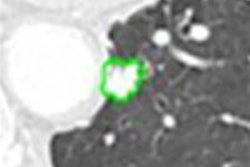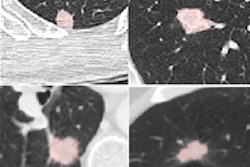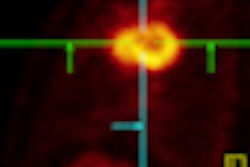The use of computer-aided detection (CAD) technology as a concurrent reader on PACS workstations can improve the performance of inexperienced readers in detecting lung nodules, according to a study from Catholic University in Rome.
The researchers found that marrying CAD with PACS yielded a significant increase in sensitivity for inexperienced readers for nodules 4 mm and larger. It also reduced reading time, according to Dr. Fabio Maggi, who presented the team's research during a scientific session at the 2010 European Congress of Radiology (ECR) in Vienna, Austria.
Several issues about using CAD in chest CT for detecting pulmonary nodules remain open, including determining the sensitivity of CAD software, its role as either a second or concurrent reader, and the influence of reader experience on performance, Maggi said.
As a result, the Catholic University researchers sought to assess a CAD system integrated in PACS as a concurrent reader for solid nodules on MDCT chest screening examinations. Fifty smokers (37 males, 13 females) with a mean age of 58 years received low-dose CT studies (16 x 1.25-mm collimation, 80-mA tube current) as part of a lung cancer screening program.
For the purposes of the study, two chest radiologists in consensus with CAD identified solid nodules (2-30 mm) to create the reference standard. Two study groups were then created on the basis of age, gender, body mass index, and nodule number.
Two second-year residents read the studies; the first resident read group A with CAD as a concurrent reader and group B without CAD. The second resident interpreted the studies of group A without CAD and group B with CAD as a concurrent reader.
The readers were asked to identify any pulmonary nodules with a diameter between 2 and 30 mm and note the location and slice number. The researchers then analyzed the performance of the readers with and without CAD in comparison with the reference standard. Reading times were also calculated.
The reference standard consisted of 150 nodules with a diameter between 2 and 13 mm and a mean of 3.88 mm. There were 79 2- to 3-mm nodules, 48 4- to 5-mm nodules, and 23 6- to 13-mm nodules. Group A included 82 nodules and group B had 68 nodules.
With the use of CAD, residents had a sensitivity of 94% for nodules 4 mm and larger, compared with 81% without CAD. The difference was statistically significant (p = 0.03).
Overall, the residents detected a total of 123 nodules, compared with 113 without CAD. Sensitivity was 82% with CAD, compared with 75% without CAD. The difference was not statistically significant, however (p = 0.14).
For nodules smaller than 4 mm, the residents had a sensitivity of 71% with CAD and 66% without CAD. The difference also was not significant (p = 0.63).
However, CAD was associated with a statistically significant decrease in reading time, falling from a mean of 10 minutes and 54 seconds without CAD to nine minutes and 25 seconds with CAD (p = 0.004).
Maggi acknowledged several limitations of the study, including its comparison of only inexperienced readers, its inclusion of a large number of small nodules, and its analysis of reading time only for nodule detection.
Nonetheless, the use of CAD led to a statistically significant increase in sensitivity for nodules 4 mm and larger, Maggi said. Its use as a concurrent reader with PACS workstation software also resulted in reduced reading time.
"CAD is useful for lung nodule detection; in particular, in a lung cancer screening program," he said.
By Erik L. Ridley
AuntMinnie.com staff writer
April 30, 2010
Related Reading
Lung CAD boosts radiologist accuracy, February 17, 2010
Integrating CAD with PACS adds clinical value, December 18, 2009
CT lung CAD helps readers differently, November 4, 2009
Brazilian team marries lung CAD with PACS, August 20, 2009
CARS report: New CAD tool follows lung nodules over time, June 30, 2009
Copyright © 2010 AuntMinnie.com



















